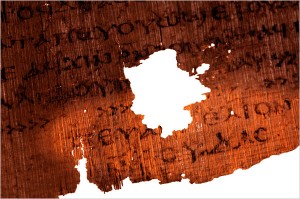(The following appeared on Larry Hurtado’s blog in regard to the Green Collection)
Newly-Identified Early New Testament Fragments?
by larryhurtado
Over the last couple of days have appeared numerous postings on reports that fragments of several early NT manuscripts have been identified (e.g., http://sheffieldbiblicalstudies.wordpress.com/2012/02/06/first-century-fragment-of-mark/). A statement by Dan Wallace in a recent debate with Bart Ehrman seems to be the source of these reports. In the debate, Wallace says that he referred to a fragment identified as part of a first-century copy of the Gospel of Mark (http://www.reclaimingthemind.org/blog/2012/02/wallace-vs-erhman-round-three/).
The fragment in question seems to be part of a collection of papyri that are part of the Green Collection (http://explorepassages.com/collection). The key figure listed as the guiding expert for the Greek Collection is Scott Carroll. One of the recent postings lists several putative early fragments of several NT writings (including some Pauline letters allegedly dated to the second century CE). According to Wallace, a formal scholarly publication of these items is in the works, scheduled to appear next year sometime.
It is entirely understandable, and yet also in some ways unfortunate, that polemicists for and against the Bible (such as the protagonists in the Wallace/Ehrman debate) have made the identification and secure dating of NT manuscripts such a controversial matter. It would be a wonderful further boon to textual scholarship to have additional early manuscripts of NT writings, even legible fragments. Among other matters, depending on the amount of text actually preserved, all portions of early manuscripts are vital for tracing the textual history of the writings they attest. With regard to NT writings, we are already in an enviable and unparalleled situation, with substantial early papyri copies of a number of them (e.g., the Chester Beatty papyri, and the Bodmer papyri). But here are some notes to bear in mind as we await further news of the putative new finds.
The identification and palaeographical dating of manuscripts requires huge expertise specific to the period and texts in question. Let’s wait and see whose judgement lies behind the claims.
Palaeographical dating can ever only be approximate, perhaps as narrow as 50 yrs plus or minus. Expert palaeographers often disagree over a given item by as much as a century or more. It’s never wise to rest much upon one judgement, and confidence will be enhanced only when various experts have been given full access to the items.
It is particularly difficult to make a palaeographical dating of a fragment, the smaller it is the more difficult. For such dating requires as many characters of the alphabet as possible and as many instances of them in the copy as possible to form a good judgement about the “hand”.
Although it rachets up potential sales of a publication to make large claims and posit sensational inferences about items, it doesn’t help the sober scholarly work involved. It also doesn’t actually accrue any credit or greater credibility for the items or those involved in handling them.
With many others, I await further news, and even more so I await more forthcoming scholarly work on these mooted items. Early New Testament fragments? As someone said when asked what he thought of the French Revolution: “Too soon to tell.”













